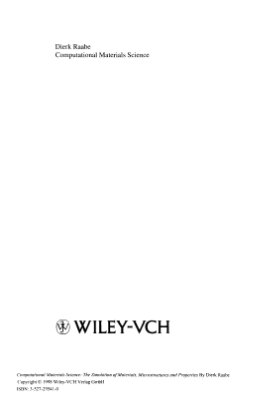Wiley-VCH, Weinheim, New York, 1998, 380 pp. - ISBN
3-527-29541-0
The recent advance of numerical prediction methods in nearly all domains of materials science and engineering has established a new, exciting, interdisciplinary approach which is often referred to as "computational materials science". It brings together elements from materials science, physics, computer science, mathematics, chemistry, and mechanical engineering. For instance, simulations in the field of materials physics concentrate on the investigation of lattice and defect dynamics at the atomic scale using molecular dynamics and Monte Carlo methods. Materials-related simulations in the field of mechanical engineering focus on large-scale construction problems, using finite element methods where the microstructure is incorporated by using averaging constitutive laws. In contrast to these examples, the classical domain of materials science can be seen in the investigation of lattice defects and their interactions at the mesoscale. Performing simulations on this particular scale is a great challenge, in that it must bridge enormous space and time scales and provide concepts to describe adequately complex many-body interaction phenomena. For this purpose a variety of new concepts has been developed which enables one to handle the interaction of many individual lattice defects in a more or less discrete manner at dimensions above the atomic scale and below the macroscopic scale. These so-called mesoscale simulation methods include deterministic and probabilistic cellular automata with global and local transformation rules, Ginzburg-Landau-type phase field kinetic methods, dislocation dynamics, polycrystal and non-linear crystal plasticity finite element models, geometrical and component models, topological network or vertex models, and multistate kinetic Potts-type Monte Carlo approaches. However, classical techniques such as molecular dynamics, Metropolis Monte Carlo, and conventional finite element simulations are also used extensively.
Contents
Abreviations Used Frequently
Symbols
Introduction
Modeling and Simulation in Materials Science
Fundamentals and Solution of Differential Equations
Statistical Mechanics in Atomic-Scale Simulations
Monte Carlo Simulation and Integration
Molecular Dynamics
Discrete Dislocation Statics and Dynamics
Ginzburg-Landau-Type Phase Field Kinetic Models
Cellular Automata
Mesoscale Kinetic Monte Carlo and Potts Models
Geometrical and Component Models
Topological Network and Vertex Models
Finite Element and Difference Methods at the Meso—Macroscale
Polycrystal Elasticity and Plasticity Models
Space and Time Scales in Microstructure Simulation
Appendices
The recent advance of numerical prediction methods in nearly all domains of materials science and engineering has established a new, exciting, interdisciplinary approach which is often referred to as "computational materials science". It brings together elements from materials science, physics, computer science, mathematics, chemistry, and mechanical engineering. For instance, simulations in the field of materials physics concentrate on the investigation of lattice and defect dynamics at the atomic scale using molecular dynamics and Monte Carlo methods. Materials-related simulations in the field of mechanical engineering focus on large-scale construction problems, using finite element methods where the microstructure is incorporated by using averaging constitutive laws. In contrast to these examples, the classical domain of materials science can be seen in the investigation of lattice defects and their interactions at the mesoscale. Performing simulations on this particular scale is a great challenge, in that it must bridge enormous space and time scales and provide concepts to describe adequately complex many-body interaction phenomena. For this purpose a variety of new concepts has been developed which enables one to handle the interaction of many individual lattice defects in a more or less discrete manner at dimensions above the atomic scale and below the macroscopic scale. These so-called mesoscale simulation methods include deterministic and probabilistic cellular automata with global and local transformation rules, Ginzburg-Landau-type phase field kinetic methods, dislocation dynamics, polycrystal and non-linear crystal plasticity finite element models, geometrical and component models, topological network or vertex models, and multistate kinetic Potts-type Monte Carlo approaches. However, classical techniques such as molecular dynamics, Metropolis Monte Carlo, and conventional finite element simulations are also used extensively.
Contents
Abreviations Used Frequently
Symbols
Introduction
Modeling and Simulation in Materials Science
Fundamentals and Solution of Differential Equations
Statistical Mechanics in Atomic-Scale Simulations
Monte Carlo Simulation and Integration
Molecular Dynamics
Discrete Dislocation Statics and Dynamics
Ginzburg-Landau-Type Phase Field Kinetic Models
Cellular Automata
Mesoscale Kinetic Monte Carlo and Potts Models
Geometrical and Component Models
Topological Network and Vertex Models
Finite Element and Difference Methods at the Meso—Macroscale
Polycrystal Elasticity and Plasticity Models
Space and Time Scales in Microstructure Simulation
Appendices

